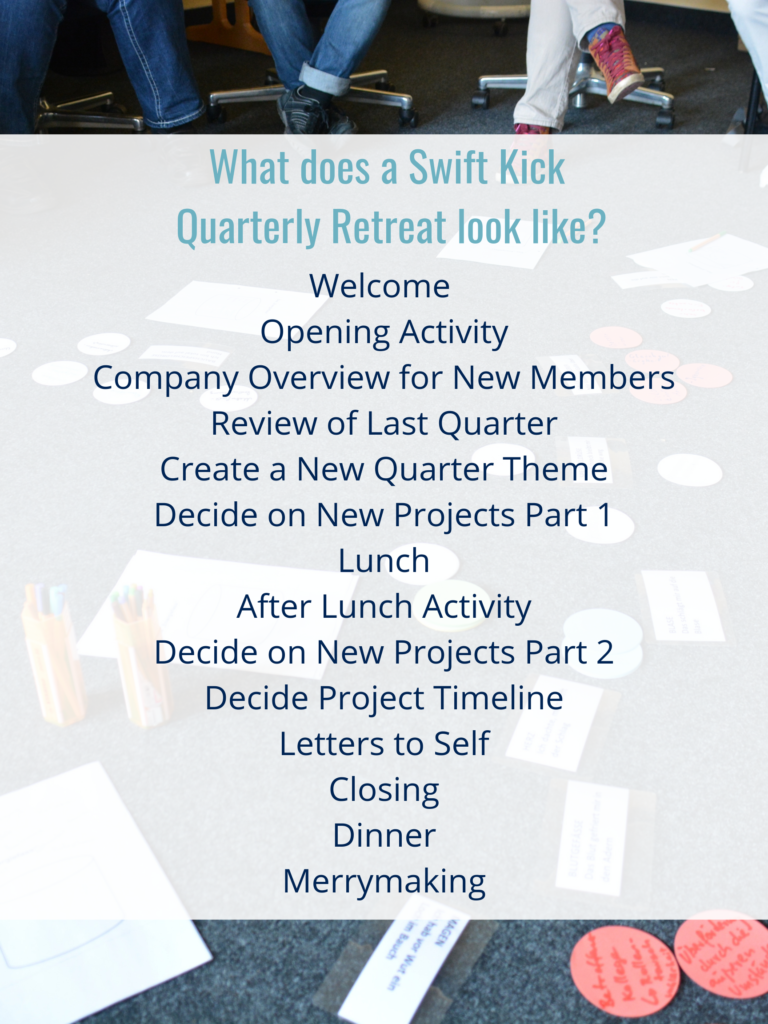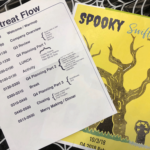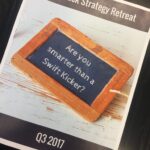Handing out pennies in Union Square, seeing a show on Broadway, riding an aquatic themed carousel, playing board games, eating bugs, and visiting a cat cafe. At some point in time, Team Swift Kick has done all of these strange things during a quarterly strategy retreat. But strategy retreats are more than just surprise activities; every quarter we jam-pack a day with goal planning and strategic thinking so we can kick butt for the next three months.
There are three main reasons to have a quarterly strategy retreat.
- To get the entire team on the same page regarding goals and projects.
- To prevent distraction over the next three months by planning every project down to the week.
- To hit refresh and have fun together.
“It’s amazing what you can accomplish when you get a hundred people all working on just 1 priority, instead of 27.”
Verne Harnish, Mastering the Rockefeller Habits
Over the years, we have perfected the schedule of our quarterly strategy retreat. We have found the right balance of fun and hard work, all smushed into one day. By the end of these (exhausting) days, we all feel accomplished and closer to the Swift Kick family. According to Marketing Innovators, teams with high morale have 20% better performance. If your team isn’t taking the time to refocus, align, and bond as a team, you’re shooting in the dark. If you want to kick-start your productivity and effectiveness, it’s so important to hit pause on normal operations to look at the bigger picture.
The Schedule for a Quarterly Strategy Retreat
The following retreat flow works great for our small team and we think it can work for yours too. The bulk of this schedule comes from Rockefeller Habits, with modifications to fit our culture and needs.

Welcome and Opening Activity
We start the day by welcoming the team to the retreat and doing a short activity to wake us up. Some examples include improv, taking “shots” of juice, and playing get-to-know-you games. These activities should be fast and get the team moving (either physically or mentally).
Company Overview
We only include this if we have new interns or employees joining the team for the first time. We review a packet of materials that gives an understanding of what Swift Kick’s vision and mission are, the Core Values, and all the ways we accomplish those things. We make sure to allow time for questions from the new people.
Review of Last Quarter
This is where we take a look at the metrics and projects from the last quarter. We review the numbers and observe whether we hit our goals. We talk about what went great and what can be fixed next time around. Once this is done, the previous quarter is closed out and we can focus on the future.
Choose a new Quarterly Theme
Now begins the focus on the new quarter! We pick a theme that embodies the overall sentiment we wish to embody for the next three months. Some examples include: Pitch or Polish, Set the Stage, Put a Bow on It, and Go For Broke.
Decide on New Projects – Review Brainstorm List and Filter by Theme
Once we have a theme, we go through the Big Brainstorm List. This list is something we have been curating for years. At any point during a quarter, a member of the team can add a new idea they have to this list. This is useful because it allows us to remember this new idea without feeling the need to get distracted from current goals by starting to work on it immediately. We know if we add it to this list, we will talk about it at the next retreat.
We go through the entire list and if something seems like it fits into the theme, we make a note of it. This smaller list is then put up on the wall for further discussion.
Lunch and After-Lunch Activity
At this point, the lunch we ordered should have arrived. We are all starving and take a real break by leaving the room and eating together. We pause the work-related talk and chat about personal stuff instead.
Once we are all happily full, we play some kind of game together. It might be a quick board game, a Swift Kick version of Jeopardy, or a crafty activity. We try to implement aspects of our core values into this activity.
Decide on New Projects – Filter by Interest and Resources
Now it’s back to work! We go back to the list on the wall from before lunch and we filter it further. We created a point system where each member has an allotted number of points for the quarter. A complicated project might equal 5 points, while a quick one might be 1 or 2. We all mark down the projects we are interested in without going over our allotted points (usually about 25 points per person).
We then further filter the list based on resources and what the quarter usually looks like. For example, if Tom and Melissa are travelling a lot, we know it might not be a good time for an in-office project that involves them.
Map out Project Timeline
This part is our real secret sauce. Once we are all in agreement that the projects left are the right ones, we sit down to map out, week by week, the tasks to complete each project. By the end of this, we know exactly what tasks for which projects we will be working on every single week for the next three months. During our weekly meetings, all we need to do is look at our Gantt Chart to see what we will each work on that week. This is how we get so much done: there’s no guesswork and no improvising. This is important because according to HBR, “When asked to identify the single greatest challenge to executing their company’s strategy, 30% cite failure to coordinate across units.” Yikes!
Closing
We end the work day by writing letters to ourselves (which we open at the beginning of next retreat). Finally, we go around the room and share our Final Thoughts – what we are feeling and thinking about the day, and the next quarter.
Dinner and MerryMaking
Now, the real fun begins! It’s usually about 5pm at this point. We head out for dinner at a fun restaurant and some bigger activity that we call “MerryMaking.” Merrymaking might be a show, an interactive exhibit, a class, a scavenger hunt, or anything fun we can do as a team.
Other Notes
There you have it! That’s our quarterly strategy retreat schedule. Here are some other things to keep in mind when planning a retreat.
- We like to give the whole day a theme. Everything from the activities to the restaurant fall under that theme. Some themes we have used are: Alice in Wonderland, Under the Sea, and Willy Wonka.
- Timing is everything. Watch the clock! Allot time for each part of the schedule and try your best to stick to it. Otherwise, you may not have time to get to the fun stuff at the end of the day.
- Put away your email. This is not the day to check email or do your normal day-to-day stuff. The whole team should be focused on the same conversations.
Ta-da! You are now ready to host your own Quarterly Strategy Retreat. Have fun!



